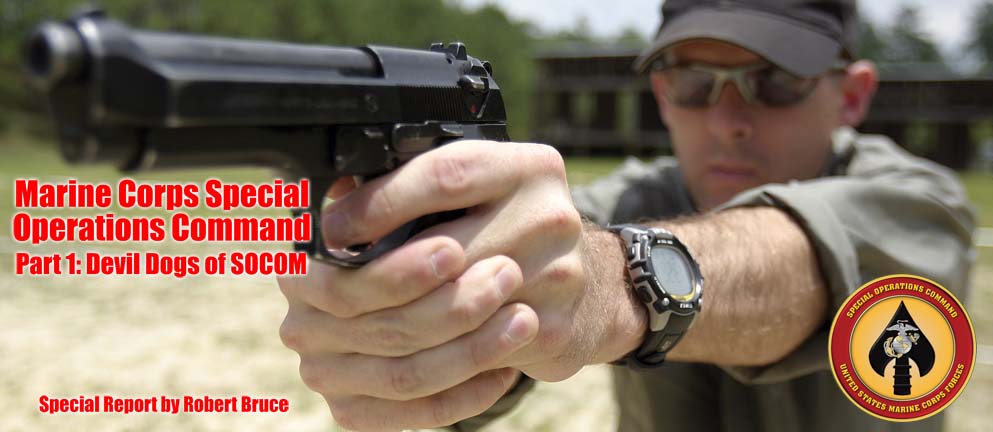30 June 2008, Camp Lejeune, North Carolina. A Marine with MARSOC’s Special Operations Advisor Group practices drawing, sighting and dry firing his 9mm M9 semiautomatic service handgun from a concealed holster. These repetitive drills are designed to build muscle memory in preparation for live fire during the Defensive Pistol Course at Stone Bay’s Military Operations on Urban Terrain Course. (MARSOC photo by Lance Corporal Richard Blumenstein)
“If we describe an all-volunteer force of warriors who share the core values of honor, courage and commitment and who are renowned for their professionalism, expertise, innovation, and superior physical fitness, you would be hard-pressed to decide whether we described Marines or SOF (Special Operations Force) operators. We found plenty of common ground to build on, but … the question at the heart of the issue is what is a MarSOF warrior” MARSOC Information paper
It defies logic that United States Special Operations Command did not include the Marine Corps until a little over four years ago. All the more so because the Corps is arguably the most nimble, aggressive and experienced component of the U.S. Armed Forces in the dirty and demanding business of fighting “small wars” in remote corners of the world.
Marines, also colorfully known as Leathernecks and Devil Dogs, are proud to be major players in more conventional aspects of the Global War on Terrorism, launched by the U.S. and allies following the murder of thousands of innocent Americans in horrific suicide attacks by Islamic extremists on September 11, 2001. But, until recently, SPECOPS missions against freedom’s many foes have been the exclusive domain of soldiers, sailors and airmen.
Lucky for USSOCOM – and not so lucky for bad guys around the globe – the puzzling omission of the Corps, with a long and rich history of success in expeditionary warfare and home to hard-charging, superbly trained Marine Force Recon, was corrected by President George W. Bush.
In October 2005, Donald H. Rumsfeld, the Bush administration’s Secretary of Defense, directed the formation of a 2,500 man Marine Component to serve with USSOCOM. Four months later, on February 24, 2006 Marine Corps Special Operations Command, led by Major General Dennis Hejlik, was formally activated at Camp Lejeune, NC.
Fast, Steep Climb
MARSOC immediately moved forward at double time with a small but highly motivated headquarters staff, drawn primarily from personnel who became available following deactivation of the 4th Marine Expeditionary Brigade (Anti-Terrorism). Urgent demands of the GWOT necessitated building force structure and conducting initial operations at the same time, which one insider said was like “painting a car while driving 50 miles per hour.”
The Foreign Military Training Unit (FMTU) was the first fully operational element, tasked with hands-on training as well as conduct of Foreign Internal Defense missions to assist friendly nations struggling against terrorist networks.
FMTU was fortunate to have quickly attracted a heavy concentration of experienced and capable NCOs with proficiency in relevant foreign languages and ability to effectively teach a wide range of practical military skills. It grew to two companies, began taking on some Unconventional Warfare/Foreign Internal Defense taskings, and its teams regularly deployed to train and advise several developing countries engaged in counter-terrorism operations.
Hejlik, appearing before a congressional committee in January 2007, noted with pride a particular success that followed MARSOC assistance to the African nation of Chad. A major assault the previous year by Islamist rebel forces advancing on the capitol was stopped and pushed back, he said, by two battalions of the Chadian military that had been trained by FMTU teams.
With FMTU’s expanding and evolving role came a name change to Marine Special Operations Advisor Group, and it has most recently restructured to become the Marine Special Operations Regiment’s Headquarters and its 3rd Marine Special Operations Battalion, both close to MARSOC’s flagpole aboard Camp Lejeune.
Door Kickers
The Corps’ Force Reconnaissance companies – repeatedly proven effective for the most demanding missions launched from land, sea and air – were essential assets in the fast and steep climb to full operational capability. In the months after the activation of MARSOC, the structure and personnel of both 1st and 2nd Force Reconnaissance Company transferred to MARSOC to form the 1st and 2nd Marine Special Operations Battalions. Both MSOBs retained their traditional home bases, with the 1st at Camp Pendleton, California, and the 2nd at Lejeune.

In the beginning, all operators in these “tip of the spear” companies already held the 0321 Reconnaissance Man MOS (military occupational specialty), designating them as elite Recon Marines. The current training pipeline for what are now called Critical Skills Operators (CSO) accepts experienced Marines and Sailors from any MOS who can meet a long and serious list of requirements. Graduates of the Individual Training Course may eventually receive an Additional Skill Identifier signifying qualification as a CSO, but for the time being a special code on their training record notes this achievement.
Marine Special Operations Teams are the basic building block for highly flexible and tailorable employment in a wide array of taskings. Marine Special Operations Company structure calls for four Teams, each usually consisting of 12 Marines plus two Navy Corpsman, all qualified CSOs with a common set of capabilities and each having additional special skills.
Teams usually deploy as part of a task-organized MSOC that is augmented by detachments from Marine Special Operations Support Group. MSOSG specialists provide necessary skill sets such as EOD (explosive ordnance disposal), K-9 working dogs, targeted intelligence, sophisticated communications, and others.
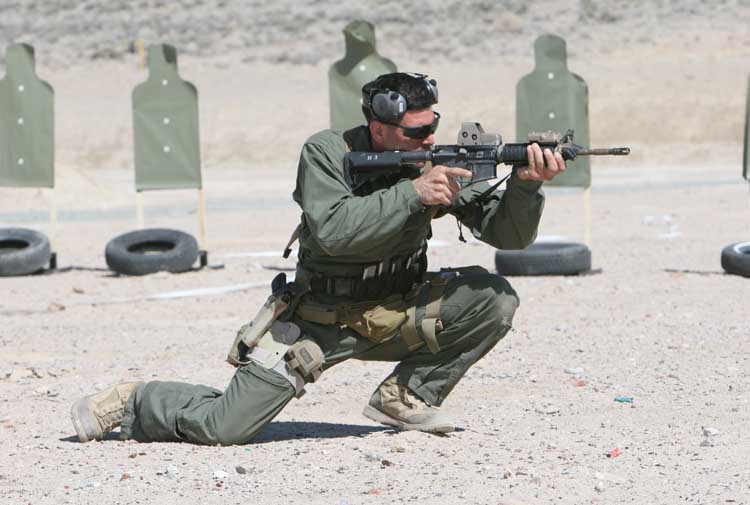
Operational tempo for these first two hard-charging battalions – colorfully known as “door kickers” for the Direct Action part of their mission capabilities – started fast and quickly grew. The first Marine Special Operations Company stood up in June 2006 and deployed to GWOT in December with 26th Marine Expeditionary Unit (Special Operations Capable). Their role was similar to the MEU’s Maritime Special Purpose Force, well equipped and manned with specialists in the conduct of maritime interdiction, deep recon, direct action, and close quarter battle.
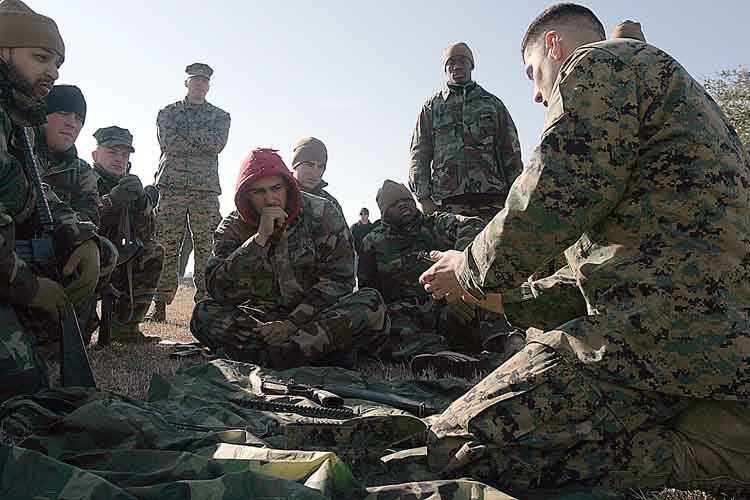
Security requirements necessarily cloud details of most subsequent missions but cross-referencing various sources reveals the number of operational activities rapidly increasing each year, most notably in Iraq and Afghanistan. By March 2009, the third anniversary of MARSOC, Marine Special Operators were regularly deploying for dozens of missions in support of Operations Enduring Freedom Afghanistan, Philippines, Horn of Africa, and Trans Sahara. The number and variety of deployments continues to grow and task forces are operating in at least four of USASOC’s Theater commands including Central, Europe, Pacific, and South.
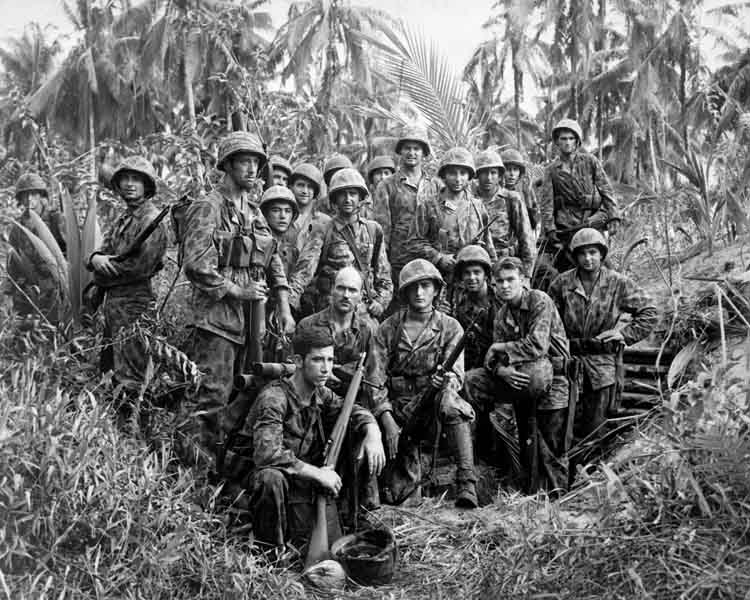

Essential Training and Support
Providing intensively trained operators to round out all twelve “door kicker” companies in the regiment’s three battalions is the responsibility of the Marine Special Operations School. Building on the structure and field work of 1st and 2nd Special Missions Training Branch, MSOS was activated in June 2007 at Camp Lejeune.
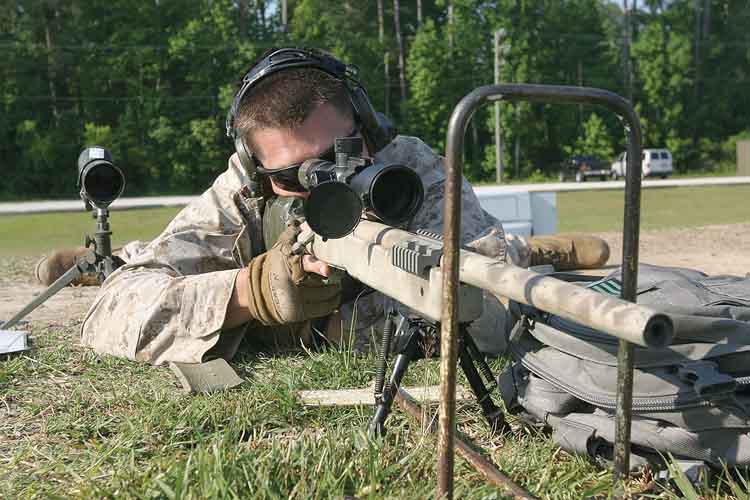
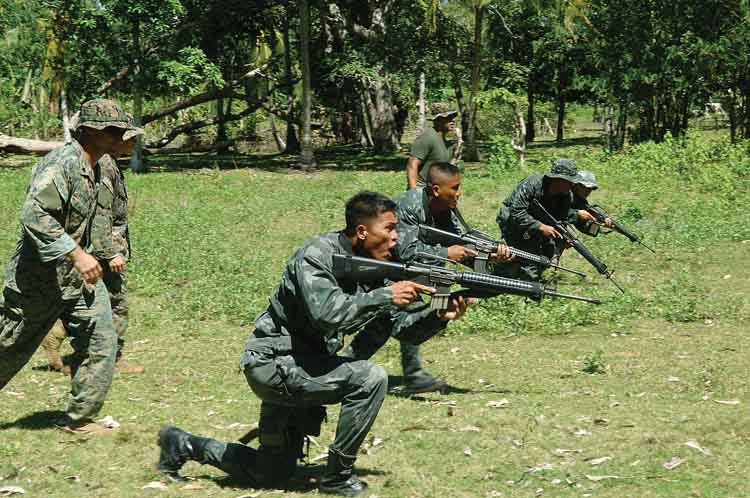
Informally known as the “schoolhouse,” it is tasked to screen, assess select, train, and certify Marine Special Operations Forces. It also has responsibility for doctrine development and serves as the proponent for evaluation of weapons and optics used throughout MARSOC.
In October 2008, all Marines seeking to become MARSOF Operators began attending Individual Training Course, an in-depth training program that covers required culture, technical, and tactical skills. The grueling seven month program of instruction gives all operators the same baseline training.
After graduation, most report to the Regiment where they will undergo further specialized training based on the unit that they are assigned to. Others will first go on to more advanced training in language and other skills like Airborne, SCUBA, and emergency medical care.
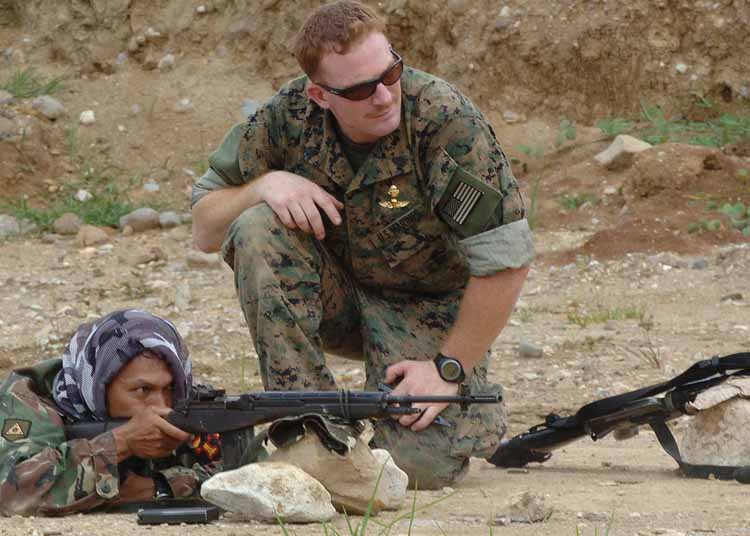
(Editor’s Note: Part two of this series will take a close look at how MARSOC’s Critical Special Operators are trained in high-stakes weapons handling and employment, as well as other critical combat skills.)
Marine Special Operations Support Group provides combat support and combat service support to MARSOC units. A Logistics Company handles food, fuel, ammunition, heavy transport, maintenance, and other essentials. A Support Company provides communications, K-9 and control elements for external sources of heavy firepower. Plans call for a full spectrum of intelligence capabilities to dramatically expand with formation of a dedicated Intel Battalion.
With its organizational structure in place and the number of assigned personnel trained and performing at acceptable level, MARSOC announced in October 2008 that it had achieved the remarkable feat of full operational capability.
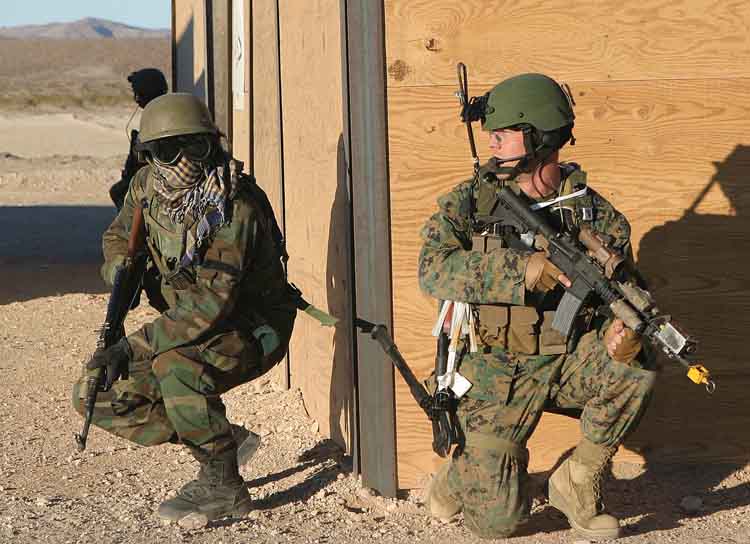
Worldwide Reach
“In all fighting, the direct method may be used for joining battle, but indirect methods will be needed to secure victory.” Sun Tzu, THE ART OF WAR, ca. 500 BC
As directed by the Commander of USSOCOM, MARSOC deploys task organized, scalable, and responsive U.S. Marine Corps special operations forces worldwide in support of combatant commanders and other agencies. While MARSOC’s contributions are not dissimilar to some in other components of USSOCOM, they are strongly influenced by the unique culture and character of the Marine Corps:
- Foreign Internal Defense (FID) – Providing training and other assistance to foreign governments and their militaries to enable the foreign government to provide for its country’s national security.
- Counterinsurgency (COIN) – Those military, paramilitary, political, economic, psychological and civic actions taken by a government to defeat insurgency.
- Security Force Assistance (SFA) – Operations, actions or activities that contribute to unified action to support the development of the capacity and capability of foreign security forces and their supporting institutions. Also, the augmentation of a foreign security force or its supporting institution in order to facilitate the achievement of specific operational objectives shared with the U.S. government.
- Special Reconnaissance (SR) – Acquiring information concerning the capabilities, intentions, and activities of an enemy.
- Direct Action (DA) – Short-duration strikes and other small-scale offensive actions taken to seize, destroy, capture, recover or inflict damage in denied areas.
- Counter-Narco Terrorism (CNT) – Military capabilities that support domestic law enforcement agencies and foreign security forces to counter activities that aid, benefit from, or are related to drug trafficking.
- Additionally, MARSOC is developing capabilities in Unconventional Warfare (UW), Counter Terrorism (CT), and Information Operations (IO).
Building future capabilities
At the end of February, 2010, MARSOC’s roster listed 1,965 Marines, 180 Sailors, and 124 civilians. This puts the command at better than 90 percent of the 2,500 personnel currently authorized. Intensified recruiting efforts within active and reserve units of the Marine Corps and Navy are underway to fill specialized MOSs in the Support Group, as well as to encourage those with the potential to become Critical Skills Operators. There is talk of an increase in the number of Individual Training Course classes to boost quantity without diminishing quality.
Under Major General Paul Lefebvre, MARSOC’s third commander, who succeeded Major General Mastin M. Robeson in November 2009, MARSOC continues reshaping and reorganizing to better balance the capabilities of MARSOF and its operator/support ratio. Standardization of the three MSOBs under the Regiment, establishment of an Intelligence Battalion and other important initiatives in the Support Group, are designed to enable a long term relevant special operations force with greater agility and self sufficiency in the execution of direct and indirect missions.
Under Construction
Evidence of some $700 million in construction projects underway was inescapable during our visit in early 2010 to MARSOC at its central complex at Lejeune’s historic Stone Bay. While an imposingly large and modern looking headquarters building, opened for business in November 2009, stood tall but alone among capacious parking lots and acres of recently-cleared land, construction crews were hard at work in several nearby locations.
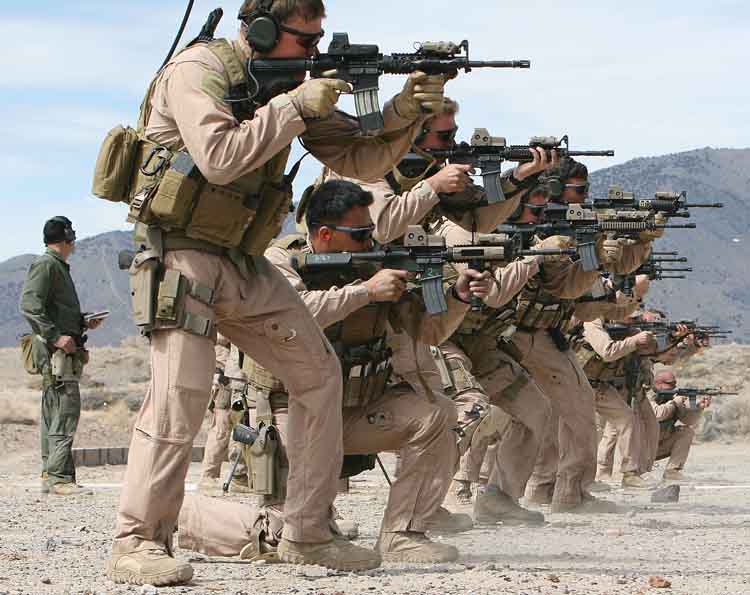
A master plan drawing shows a sprawling campus with numerous specialized ranges, shoothouses, tactical training areas, armories, logistics centers, motor pools, helipads, and much more. These, along with the excellent infrastructure and air/land/sea geographical advantages of MCB Camp Lejeune and Marine Corps Air Station New River, as well as tactical and strategic airlift assets at nearby Pope Air Force Base, provide most everything needed for training, launching and sustaining global-reach special operations.
Marine Corps Warriors
“The MARSOC Marine secures victory by going forth with our allies to fight the next battle before it begins.” (MARSOC recruiting video)
So, what is a MarSOF warrior? How does he differ from other Marines?
Answers to these fundamental questions were provided by MARSOC in a particularly detailed information paper that was published in the Marine Corps Gazette’s August 2008 issue and excerpted here with MCG permission:
Whether deployed as part of a joint special operations task force, a Marine MSOC or MSOT, or as a task-organized enabler detachment of just a few Marines and corpsmen, our silent warriors are strategic and tactical force multipliers. They must be able to operate in austere environments far from the combat service support generally available to Marine Corps forces.
For example, a key distinction between MSOCs and traditional rifle companies is that MSOCs deploy to an area of operations in order to find, plan, and execute missions independently rather than to conduct a preplanned mission. Such missions can range from direct action and special reconnaissance one day to foreign internal defense or unconventional warfare the next based on intelligence gathered and opportunities identified. This does not require a better Marine, but it does require a Marine with a unique combination of skills, experience, traits, and specialized training.
To succeed at the range of specialized missions they will conduct, MarSOF Marines and corpsmen must be multilingual, compassionate, determined, mature, team oriented, culturally aware, physically fit, capable, disciplined, independent, experienced, and mentally fit. Many of these qualities are developed during initial Marine Corps training; others are honed during deployments in Iraq, Afghanistan, and other areas of operations throughout the GWOT.
Learn More
MARSOC has an excellent website, with information on all aspects of this vital “tip of the spear” component at www.marsoc.usmc.mil.
Up Next
SAR visits MARSOC’s “schoolhouse” for a look at special operations weapons training. Our report includes conversations with some of the battle-hardened Marine NCOs who have been brought in from muddy-boots operational deployments. These men have a critical role as Instructors in the Individual Training Course and some follow-on Advanced coursework. Don’t miss it!
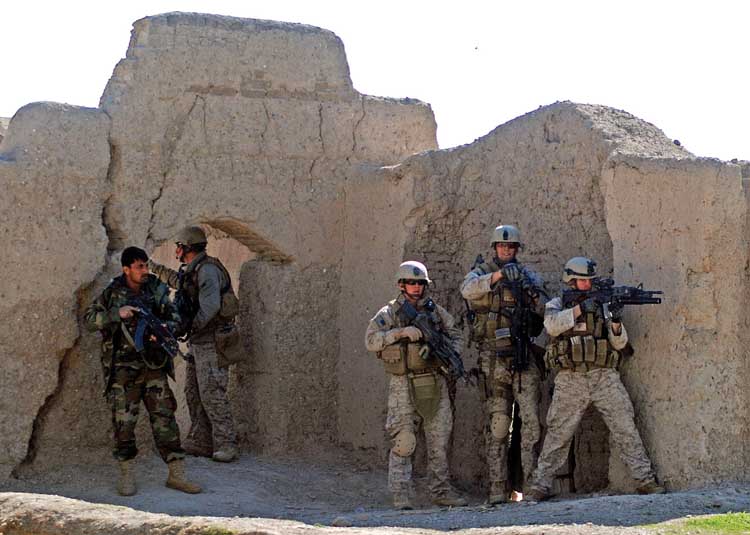
(SAR extends special thanks to MARSOC’s Public Affairs Office for exceptional assistance in arranging interviews and photo opportunities during our visit, then following up with much additional information and graphic elements.)
| This article first appeared in Small Arms Review V14N1 (October 2010) |



